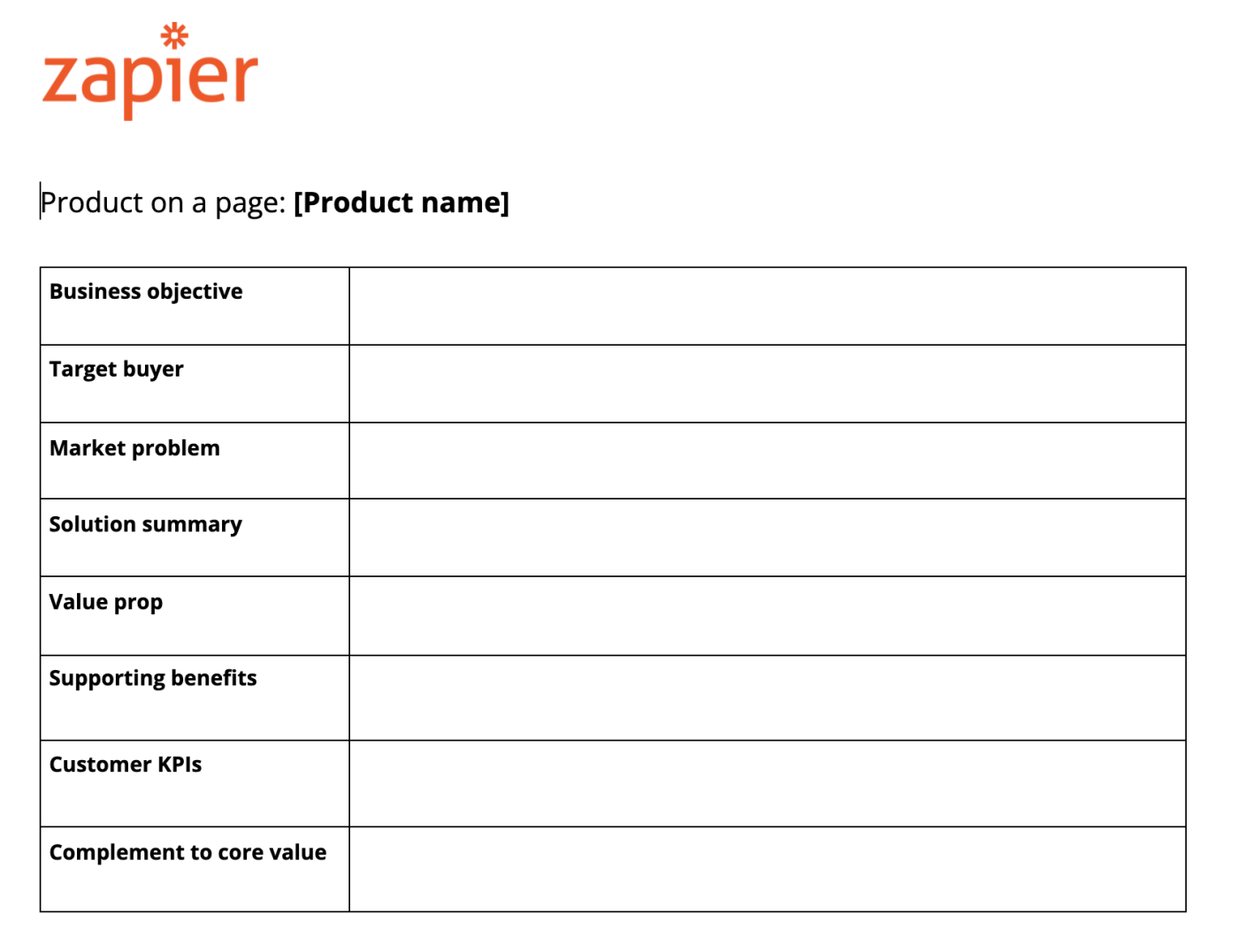Products are complicated. That's true whether you're talking about a new app feature with nuanced code and UX decisions or a new gluten-free dog treat for an online pet store. So how do you communicate a product to your marketing team in a way that helps them understand the core value, while still letting them use their expertise to market it appropriately?
I basically just described what a product marketer does. But having that information in a human's brain isn't valuable—as a product marketer, I need to make sure it's available to my entire marketing team. At Zapier, we do this via my favorite invention: Product on a Page™. (Not really ™, but it looks more official that way.)
What is a product on a page?
The product on a page succinctly tells the story of a product (or feature) for both the business and the customer. It captures the strategic overview of the product in order to facilitate a common understanding across team members. To do this, it answers questions like:
Who is this product for?
What problem does it solve?
What does success look like?
You're creating this document for the rest of the marketing team, so they can work their magic and get your audience on board.
Because it's Product on a Page™ and not Product on Two or Three Pages™, make sure to keep it to a single page. Do the work to home in on the most important parts of the product story you want to tell. If it's longer, you're getting into the weeds too much—you want to be sure you're distilling things down to their essence.
Product on a page template
Here's the product on a page template. Keep reading for more information on what to include.
Business objective
In this section, you're answering the question: why is this good for business?
Are you trying to increase adoption among a specific customer segment? Take market share from a competitor? Drive expansion revenue? Learn more about your customers? Something else? Whatever the goal is, list it here.
Target buyer
Who is this product for? What do you know about them? The more specific you can be, the better, since you're talking about one specific product, not your whole business. For example, instead of just saying "leads" or "existing customers," say "leads who XYZ" or "existing customers that have done XYZ."
Remember that your product should always have a core buyer—you'll always have different kinds of customers, but you should craft your strategy with one type of person in mind.
Market problem
What's the problem that your audience is experiencing that requires this solution? Sometimes we break this up into two parts:
Market problem. This is the general problem your customer (or potential customer) is trying to solve.
User/customer problem. This is the shortcoming of your existing solution that you're trying to improve with the new product or feature.
For example, if you were introducing gluten-free dog treats to your pet store catalog, the market problem might be: "All affordable dog treats have gluten in them, and my pup has a sensitive stomach." The user/customer problem would be: "Winston's World of Whimsy has the most affordable treats, but they all contain gluten."
Solution summary
How will this new product solve the market problem you just laid out? This is the "what" of the product (the "why" comes next). You'll want to phrase this as if you're speaking to prospects or customers. While the various marketing teams may not pull it word for word, it can be a great starting point for descriptive messaging.
For example, "Winston's Wheatless Wonders give you a gluten-free option at an affordable price."
Value proposition
Now we get to the "why." This is where you'll put a succinct statement of the product's value to potential buyers. Again, phrase your value proposition (most people shorten this to "value prop") as if you're speaking to the customers—this one's likely to be pulled into marketing copy.
Following the same example as the solution above, the value proposition might be "Winston's Wheatless Wonders keep your pup—and your wallet—healthy."
Supporting benefits
This part allows you to be super succinct in the value prop section above. The value prop should be the one thing you want to be sure your leads and customers understand. But if they're still hesitant after hearing that, what else do you have in your arsenal?
If you think of your product as having a single landing page, the value prop would be the header, and the supporting benefits would be the stuff below the fold. Benefits should give people reasons to believe that you can actually deliver the value you promised.
You can talk about features here, but be sure you're starting with the benefit. For example:
No need to sacrifice your best friend's preferences—these treats come in five different, delicious flavors.
Know you're giving your pup the best—these treats are veterinarian-approved.
Customer KPIs
Here you'll list the metrics you want to follow. How do you know if this product was a success? For SaaS companies, these would likely be usage metrics. For our online pet store, it might be number of five-star ratings or rate of product returns. This helps marketers, who might be a bit more removed from the product-focused metrics, to keep their eye on the prize.
Complement to core value
Finally, you want your marketing team to understand how this new product fits within or adds value to the rest of the business. That will help them market it to existing customers, and it will also help contextualize not just how, but where in your marketing campaigns to highlight it.
Remember, this product on a page is a living document. Create a low-fidelity version once the product is actively being developed, and then keep it updated throughout the product's lifecycle—including post-launch, if you learn more about how to market it or its value.






